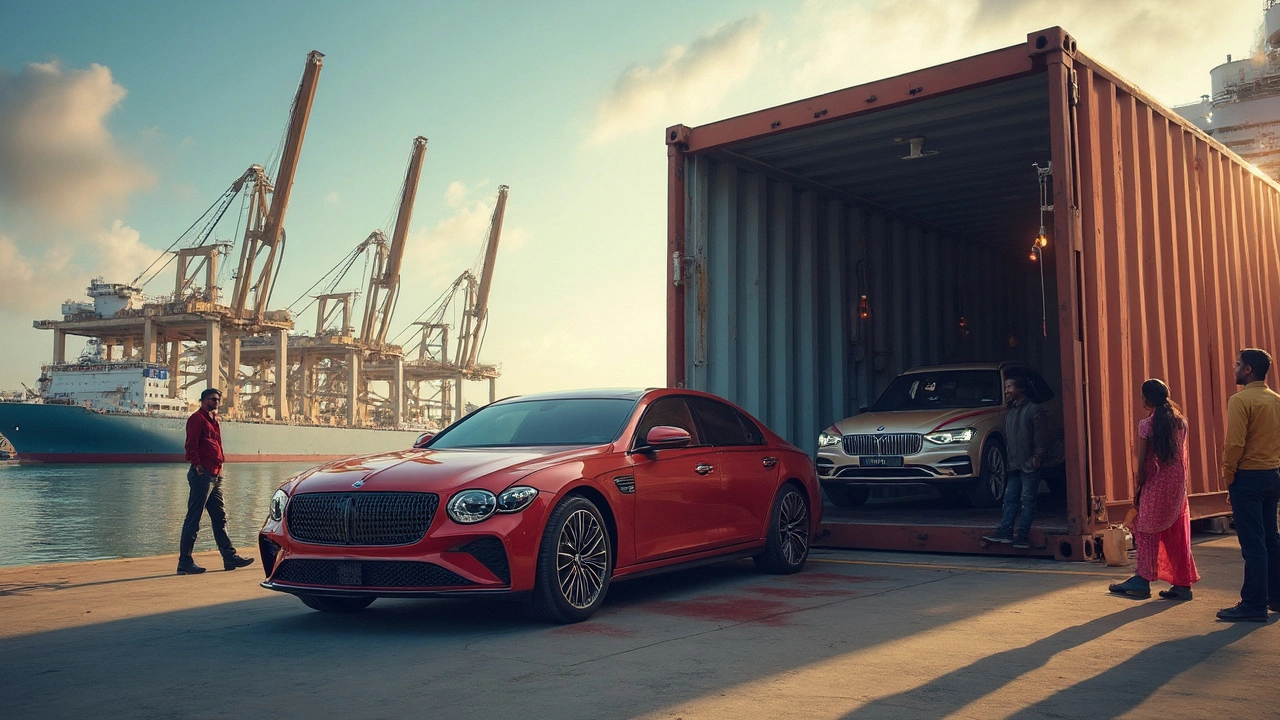Picturing your American car cruising down Indian roads? The dream is real, but it comes tangled in red tape, paperwork, and some headaches nobody warns you about. There's no magic genie to teleport your wheels from the US to India, but let's drag every detail into the light so you know exactly what’s involved. Spoiler: every step matters, and mistakes can cost you thousands or send your precious ride on a never-ending customs vacation.
What Does It Actually Take to Ship a Car from the USA to India?
Right, so there’s no simple form you can fill out, wire a bit of cash, and wait for your car to show up at Mumbai port with a big red bow. Shipping a car internationally—especially to India—involves a web of rules set by both US and Indian authorities. These rules change, and getting them wrong can mean lost money or even losing your car at port (seriously—there are tons of horror stories online about cars stuck in customs purgatory for months or sent back at the owner's expense).
First thing: personal imports are allowed under specific conditions. India only lets you import a car for personal use if you meet specific criteria. For example, the car must be right-hand drive and must not be older than three years from the date of manufacture. Most American cars are left-hand drive, and making that switch isn't cheap or easy. Even if you plan to import a classic car, there's a separate set of rules—it’s far more complicated and usually not worth the hassle unless you’re a die-hard car collector.
You must hold either Indian citizenship or a valid long-term visa. Non-resident Indians (NRIs), Persons of Indian Origin (PIOs), and Indian nationals can bring cars for personal use. You need to have lived abroad for at least two years, and the car can't be sold or transferred in India for at least two years after import.
Now let's talk money. Shipping charges vary, but sending an average sedan from New York or LA to Mumbai costs anywhere from $1,500 to $5,000 just for ocean freight. That’s before you account for port fees, unloading, insurance, and—brace yourself—India’s eye-watering import duties, which can almost double the actual cost of your car. For most cars, you’ll fork over 100% to 150% of the car's assessed value (and customs officers use their own valuation tables, not what you say you paid). Even a used car worth $10,000 can trigger duties well above $12,000.
Shipping companies usually offer two main options: container shipping (best if you’re shipping other stuff with your car or want peace of mind) or roll-on/roll-off (RoRo), where your car is loaded and unloaded under its own power. Containers cost more but protect the vehicle better, while RoRo is cheaper and faster but riskier for luxury or classic cars.
Here’s a quick checklist for legal requirements and paperwork you’ll need:
- Original purchase invoice or bill of sale
- Original registration documents and title
- Insurance documents (both US and Indian insurance may be required)
- Bill of lading from the shipping company
- Passport and visa/OCI documents
- Customs clearance forms (which you’ll get from a registered clearing agent in India)
- Roadworthiness certificate
- Pollution control certificate (can be obtained once your car arrives in India)
One tip: Don’t rely entirely on a shipping company’s promises. The big-name companies know the ropes, but plenty of smaller outfits take shortcuts. If you’re not careful, you’ll get stuck with fake certificates or incomplete paperwork, and then customs officials will start asking awkward questions (and delays).
Timing complicates things too. From booking shipping in the US to customs clearance and getting your car out of port in India, expect the entire process to eat up six to twelve weeks, even in a best-case scenario. If your car gets flagged in customs for any reason—missing papers, compliance checks, or a random inspection—add several more weeks to that.

Breaking Down the Real Costs: More Than Just Shipping Fees
Everyone hypes about "cheap international car shipping," but numbers can spiral if you’re not careful. Let's break it all down so you can budget without any nasty shocks. Remember, the ship car to India process is almost always way pricier than people think.
You’ll shell out for the actual transport first. That’s the container or RoRo fee, as mentioned, running between $1,500 and $5,000 for basic sedans and regular SUVs. If you want to send a luxury car or something heavy, costs tick up accordingly. Peak season—like around holidays—means higher prices and longer waits, so shipping off-season can save cash and stress.
Next up, you have destination charges. Ports in India (Mumbai, Chennai, or Kolkata are popular) add documentation, unloading, and warehousing fees. Expect another $500–$1,000 depending on the port and how long your car sits before you collect it.
Now the killer: customs duties. The Indian government breaks it down like this, as of the latest June 2025 rates:
- Standard import duty: 125% (can be as high as 165% for luxury cars)
- Integrated GST (IGST): 18% on most vehicles
- Compensation cess (mostly for high-end vehicles): up to 22%
It gets confusing, but here’s a real-world example. Let’s say you’re bringing in a five-year-old Honda Accord valued at $12,000. Calculated duties and taxes can easily cross the $15,000 mark, which means your car is now worth more in taxes than the car itself. This math gets even crazier for classic cars or anything with a big engine—don’t be surprised if fees on a Mustang or an F-150 cross $30,000. That’s not counting local registration and road taxes you’ll pay once the car is finally street-legal in your city.
Is it worth it? The answer’s personal. For sentimental reasons—maybe it's your first car, or you’ve spent years rebuilding it with your bare hands—money sometimes doesn't matter. But for most people, when cold numbers come out, selling your US car and buying a similar one in India is almost always cheaper and easier. One thing you can’t ship is your US petrol prices; fuel costs in India are much higher, and spare parts for American-spec models are thin on the ground, which means you could wind up with a beautiful piece of driveway art if something breaks.
Don’t forget about insurance. You’ll need a marine insurance policy to cover the shipping journey, plus Indian car insurance for the moment your car lands. Policies aren’t always easy to get if your car’s not sold in India, and premiums can be steep. Also, some states require extra environmental checks for imported cars, so factor in potential fees for modifications or certifications.
A hidden cost? Time. Delays aren’t just annoying—they’re expensive, too. Ports charge storage fees if you don’t collect your car soon after it arrives, or if customs procedures drag on. I talked to a bloke who shipped his Ford Focus from Houston; customs held it up for three weeks over a missing pollution certificate, and he paid almost $2,000 in daily port storage fees alone.

Best Tips, Pitfalls, and Real-Life Lessons When Importing to India
If you’ve made it this far, you’re either serious about bringing your car to India or very curious about car import horror stories. Here’s what I’ve learned from people who’ve done it (and a few who wish they hadn’t):
- Do your homework. Double-check every import requirement with an official government website or a trusted customs clearing agent before you even book the shipping. Rules change fast, especially with Indian imports.
- Stick to brands that already have a presence in India. Random models or rare American brands can be tough to service. Even a Chevy Malibu or a Dodge Charger will get you odd looks at local service centers.
- Convert the steering, if possible, before shipping. Indian roads run on the left. Most insurance and registration offices in India won’t touch a left-hand-drive vehicle, no matter how special it is. Understanding this one rule can save you months of heartache.
- Hire a customs broker or shipping agent with actual references. Skimping on professional help is a bad idea here. Look for reviews that mention successful car deliveries in India. Ask for copies of similar recent projects, not just promises.
- Verify your documents before you leave the US. Incomplete paperwork is the main reason for mega-delays or refusals. Remember, Indian customs are obsessed with original documents and proper signatures, not scanned copies or "digital certs."
- Budget for repairs and replacement parts. Some emissions systems, air conditioning refrigerants, or security tech in US cars don’t play nicely with Indian regulations or weather. A mate shipped his Tesla only to find service options were years behind US standards.
- Insurance is non-negotiable. Don’t even think about shipping your car without full marine transit insurance and a solid Indian car insurance policy ready to go.
There are a few quirky loopholes: If you’re a diplomat, you get a pass on some duties, and if you’re relocating under certain government schemes, rules might be laxer (but documentation is still ironclad). For the average car owner, expect lots of forms, waiting time, and the very real possibility your car ends up costing twice what you expected.
Want a fast hack? Sometimes, people just don’t bother with the hassle. They sell their US car and buy something in India instead—often a similar model, minus the headaches of customs, conversion, and waiting. But if your car means more than money (or you love a challenge and have deep pockets), then go ahead. Just keep your eyes wide open. No one ever said car shipping was simple, but hey, it makes for one wild story at your next dinner party.
